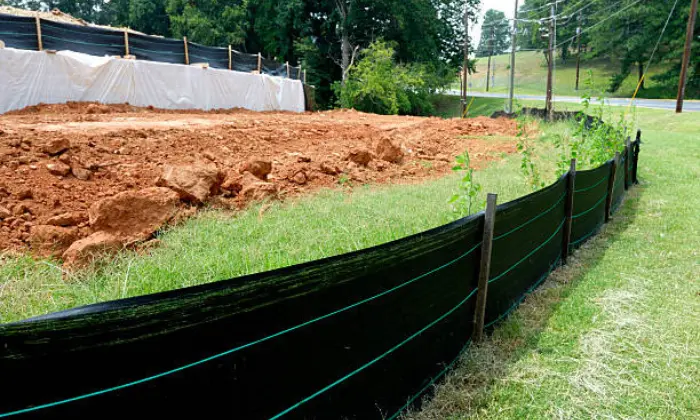- (562) 208-0148
- robertscompletecare@hotmail.com
Erosion Control Guide For Your Gardens and Yards
Erosion control is the process of managing or preventing soil erosion. Soil erosion is a natural process that can be accelerated by human activities such as farming, construction, and even recreation. Erosion control measures can help to reduce the rate of soil erosion and protect against its damaging effects. Common control measures include tillage, crop rotation, contour plowing, terracing, and the use of cover crops. In some cases, mechanical methods such as barriers and blankets may also be used. The type of erosion control measure used will vary depending on the specific situation.
Contact us at Robert Complete Care for any kind of information related to your garden or yard. We have team of experts, they will guide you each and everything. So don not wait! Call us today.

All about the Erosion Control
There are a variety of erosion control measures that can be used to protect against soil erosion. These include tillage, crop rotation, contour plowing, terracing, cover crops, riprap, landscaping, drainage systems, revegetation, and retaining walls.
Each of these measures has its benefits and drawbacks, so it is important to consider the specific situation before selecting control measure. By taking the time to choose the right type of erosion control for your property, you can help to protect against soil loss, flooding, and other issues.
Landscaping Erosion Control
Riprap is often used in conjunction with other types of erosion control, such as vegetation or gabions. Riprap can be effective at controlling erosion, but it can also be expensive and difficult to install. As a result, it is important to carefully consider all options before choosing a particular type of control. Landscaping is one of the most important ways that we can control erosion.
By strategically placing plants, we can help to hold the soil in place and prevent water from running off too quickly. In addition, organic materials like mulch can help to protect the soil and absorb excess moisture. There are several other measures that we can take to control erosion, including installing drainage systems and creating berms. By taking these steps, we can help to prevent the damaging effects of erosion and keep our landscapes looking their best.
Riprap Erosion Control:
Riprap erosion is a common type of erosion control. Riprap consists of large rocks or boulders that are placed along the banks of rivers or streams. The stones help to dissipate the energy of the water and prevent the bank from eroding.
Drainage Systems control Erosion:
The installation of proper drainage systems is an important part of erosion control. Drainage systems can help to reduce the rate at which water flows off your property, thus reducing the amount of soil that is carried away by runoff. In addition, they can also help to minimize flooding and provide an outlet for excess moisture. There are several different types of drainage systems, including surface drains, subsurface drains, and French drains. By choosing the right type of system for your property, you can help to ensure that erosion is kept to a minimum.
Revegetation Erosion Control:
Revegetation is another important component of erosion control. This involves planting vegetation such as grass, shrubs, and trees on slopes or other areas prone to erosion. The vegetation helps to hold the soil in place and prevent it from washing away. In addition, the roots of the plants can help to absorb excess moisture and reduce runoff. Revegetation is a cost-effective way to protect your property against erosion and should always be considered.
Retaining Walls:
Retaining walls are another common erosion control measure. These structures help to hold back soil and prevent it from being washed away by runoff. Retaining walls can be constructed out of various materials, including stone, concrete, timber, and steel. Depending on the type of wall you choose, they can provide both a visual and functional element to your landscape. However, they should be carefully designed to ensure that they are stable and secure.
Erosion Control Matting:
Erosion control matting is a type of geotextile fabric that helps to reduce erosion on slopes or other areas prone to soil loss. The fabric is installed over the topsoil and then covered with mulch or other materials. This helps to trap moisture and hold the soil in place, thus reducing the chances of it being washed away by runoff.
Erosion control matting is often used in conjunction with other methods of erosion control, such as vegetation or retaining walls. It is an effective way to protect your property against soil loss and should be considered when planning any landscaping project.
Erosion Control Plants:
Erosion control plants are specially designed plants that help to stabilize the soil and protect it from being washed away. These plants typically have deep root systems that help to anchor the soil and hold it in place. In addition, they can also absorb excess moisture and reduce runoff. There are a variety of erosion control plants available, each with its characteristics and benefits.
By carefully selecting the right type of plants for your landscape, you can help to keep your property looking its best and protect it from erosion.
Erosion Control Fabrics:
They are also commonly used to protect slopes and other areas prone to soil loss. These fabrics are designed to trap moisture, reduce runoff, and hold the soil in place. The most common type of fabric is a woven geotextile fabric that is installed over the topsoil and then covered with mulch or other materials. This helps to protect the soil from being washed away and also keeps it in place, thus reducing erosion.
Erosion Control Suppliers:
When planning an erosion project, it is important to find a reputable supplier of products and materials. A quality supplier will be able to provide you with the right type of products and guidance so that your project can be completed successfully. Your local landscape supply store may carry some erosion control supplies, but for more specialized items you should look into ordering them online.
Look for a supplier that offers a wide selection of products, competitive prices, and excellent customer service. By taking the time to research your erosion control options, you can protect your property from soil loss and help to keep it looking its best. There are many different methods available, so make sure to choose the one that is right for your situation.
Erosion Control Plans:
Landscaping erosion control plans are designed to minimize the effects of erosion on landscaping. There are a variety of measures that can be taken to control erosion, and the best method will vary depending on the specific needs of the landscaping. One common measure is to create a buffer zone between the area susceptible to erosion and the rest of the landscaping.
This buffer zone can help to absorb some of the energy from rainfall and runoff, which can help to reduce the amount of erosion that occurs. Additionally, it is important to ensure that all plants are properly watered and that any areas susceptible to erosion are seeded with grass or another ground cover.
It is an important tool for protecting your property from soil loss and keeping it looking its best. With the right strategies and products, you can successfully reduce erosion and protect your landscaping for years to come. If you are unsure of which methods or materials are best for your situation, consult a professional landscaper for advice and assistance. With the right plan in place, your property will remain safe from erosion and look beautiful
Erosion Control professionals
These professionals are specially trained in the field of erosion and sediment control. It is the practice of preventing or controlling wind and water erosion to protect people, property, and infrastructure. These professionals use a variety of techniques to prevent or control erosion, including grading, support structures, vegetative cover, barriers, and drainage features such as swales and catch basins.
These professionals are familiar with local conditions, regulations, and best practices to effectively control erosion. In addition, Erosion Control professionals can communicate effectively with clients, landowners, government officials, and other stakeholders. It is a critical field that helps to protect our communities from the damaging effects of erosion. Erosion Control professionals play a vital role in keeping our environment safe and healthy.
Garden Maintenance
At Robert Complete Care, we understand that a beautiful garden requires more than just planting seeds; it demands meticulous Garden Maintenance. With a passion for preserving the natural beauty of outdoor spaces, we offer a comprehensive range of services to ensure your garden thrives year-round. Our dedicated team of experts is committed to nurturing your garden, from regular lawn mowing and pruning to seasonal planting and pest control.
Conclusion
Erosion control is an important part of preserving and protecting your property. There are a variety of methods that can be used to reduce erosion, such as the use of mulch, erosion control plants, and fabrics. Additionally, it is important to find a quality supplier for any materials or products needed for the project. With careful planning and the right tools, you can successfully reduce erosion and protect your property for years to come.
By following the steps outlined above, you can ensure that your landscaping project is successful and that it remains safe from soil loss due to erosion. With a comprehensive erosion control plan, your property will remain beautiful and well-protected for the long run. For more information call us at Robert Complete Care.
FAQs
Q: What is erosion control?
A: Erosion control is the process of reducing or preventing soil loss from water, wind, and other erosive forces. It typically involves the use of mulch, erosion control plants, fabrics, and other measures to keep soil in place and prevent it from being washed away.
Q: How do I choose the right erosion control products?
A: When choosing erosion control products, it is important to consider the specific needs of your property. Consider what type of soil you have, as well as any areas prone to heavy rainfall or runoff. It may also be helpful to consult with a landscaping professional who can advise you on the best products for your situation.
Q: How often should I inspect my erosion control measures?
A: It is recommended to inspect your erosion control measures at least once a year. Look for signs of wear and tear, such as thinning mulch or damaged fabrics, so that any necessary repairs can be made. Additionally, you should check the soil to ensure that erosion is not occurring.
Q: Can I install erosion control measures myself?
A: Yes, it is possible to install some types of erosion control measures yourself. However, for more complex projects, it may be best to consult with a professional landscaping contractor who can provide the necessary expertise and resources.

